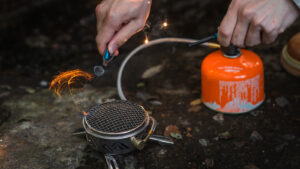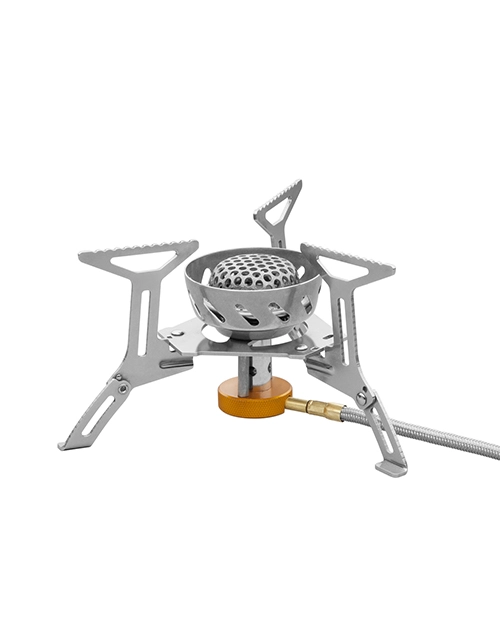
Cooking at a campground is highly threatened by wind. It may blow out fires and squander fuel. Oftentimes, an excellently designed windscreen silently supports victorious wilderness meals by protecting delicate burners against gusts.
This guide will put an end to this argument between these two types of windscreens. We will explore their unique advantages and disadvantages, thus enabling you to choose either a remote canister stove’s windscreen or a conventional one. Our comparison will help you choose the best windscreen for your remote canister stove.
Remote Canister Stoves Windscreen vs Traditional Windscreen – Pros and Cons
In outdoor cooking, protection from the wind is vital for both effectiveness and safety. Campers and hikers frequently debate whether it is better to use remote canister stove windscreens or their traditional counterparts, as they offer different advantages, respectively. These differences are important for making educated decisions as regards one’s outdoor kitchen setup. Now let us have an analysis of each option’s pros and cons:
Remote canister stoves windscreen pros:
- Increases safety: these windscreens help keep the flame from the fuel canister, thus reducing the probability of overheating and explosions.
- Better heat distribution: The remote design leads to more even heat distribution, which means better cooking results.
- Steadiness: Remote setups have a low center of gravity, thereby increasing stability on uneven surfaces.
- Fuel efficiency: These windscreens improve fuel efficiency by effectively shielding the flame, resulting in more cooking time per canister.
- Versatility: Many remote windscreens are compatible with a variety of stove brands, a feature that makes them perfect for people who own several stoves.
Cons:
- Heavy weight: Compared to traditional options, remote set-ups usually weigh more, which may be an issue for ultralight backpackers.
- Complexity: Assembling and disassembling these systems takes longer due to having multiple components, especially in harsh weather conditions.
- Costly: Many times you will find out that remote canister stove windscreens are quite expensive, hence not suitable for casual campers.
- Space-consuming: Their design therefore calls for additional space requirements that can be challenging to store in cases of limited storage.
Traditional Wind Screen Pros:
- Light-weight: They are made using light materials such as aluminum foil, so they don’t carry a lot of weight when added to your bag.
- Affordability: Generally being less expensive, they provide a budget-friendly way to cover your flame from the wind.
- Packability: It is common that these screens can often be rolled or folded so that they fit in your backpack with no trouble.
- Customization: Many outdoor enthusiasts prefer DIY traditional windscreens since they can be tailored to suit individual needs.
Cons:
- Limited Protection: Traditional screens cannot completely prevent the wind from blowing off your flame because strong gusts of wind have an influence on it.
- Safety Concerns: When improperly used, these screens may increase the risk of overheating the canister. Always follow the manufacturer’s guidelines.
- Durability: Lightweight materials found in them tend to wear out quickly and thus require faster replacements than remote systems do.
- Less Stability: Such screens do not contribute to stove stability, meaning that you need a separate, stable cooking surface for your stove.
- Reduced Efficiency: Although remote options offer more fuel efficiency and a larger amount of protection, traditional screens might not help to save fuel as well as remote alternatives will.
Choosing the Right Windshield for Cold-Weather Camping
Choosing either remote canister stove windscreens or traditional windscreens depends on what one values most. Trip length, weather conditions, and cooking style are some factors that should be considered. Remote options score better on safety and efficiency but add weight.
Remote canister stove windscreens are often better in harsh conditions or on longer trips because they offer more security and fuel efficiency. Traditional windscreens will be good enough for weekend campers or fair-weather hikers; at least these low-tech options are a step up from no windscreen at all. With your own camping style, budget, and gear preferences, you can learn how to select the best windscreen for your outdoor needs.
Does a Remote Canister Stoves Windscreen Work with All Canister Sizes?
Compatibility with different canister sizes is very important when selecting a remote canister stove windscreen. Most remote canister stove windscreens are made to suit various canister sizes, ranging from small 4-ounce ones to larger 16-ounce ones. This adaptability allows you to change from one size of canister to another depending on your duration of stay on the trip and the kind of food you are cooking.
However, not all remote windscreens are universally compatible. You must confirm if both the windscreen and your stove fit properly by looking into their specifications. Some screens have adjustable features that will suit different heights and widths, hence making them versatile.
On the other hand, others might only work with certain brands or models of cook systems, while others may not fit other gas tanks whatsoever.
Folding Remote Canister Stoves Windscreen for Easy Storage
A folding remote canister stove windscreen, the Trail Designs Caldera Cone, for example, offers convenient storage and efficient wind protection when cooking outside. It covers the flame just right yet still remains collapsible, allowing for folding down to a simple backpack or other small storage. Opting for a model as collapsible as the Caldera Cone helps enrich your camping experience with convenience and the elimination of bulk.
Conclusion
Choosing the right fuel and windscreen is critical if the cold camping experience is going to be successful. Remote canister stove windscreens offer improved safety and efficiency, while traditional windscreens provide simplicity and affordability. Look into factors such as compatibility, storage capacity, and performance to choose what works best for you. Proper preparation will guarantee safe and enjoyable outdoor cooking, notwithstanding the weather conditions around us.















